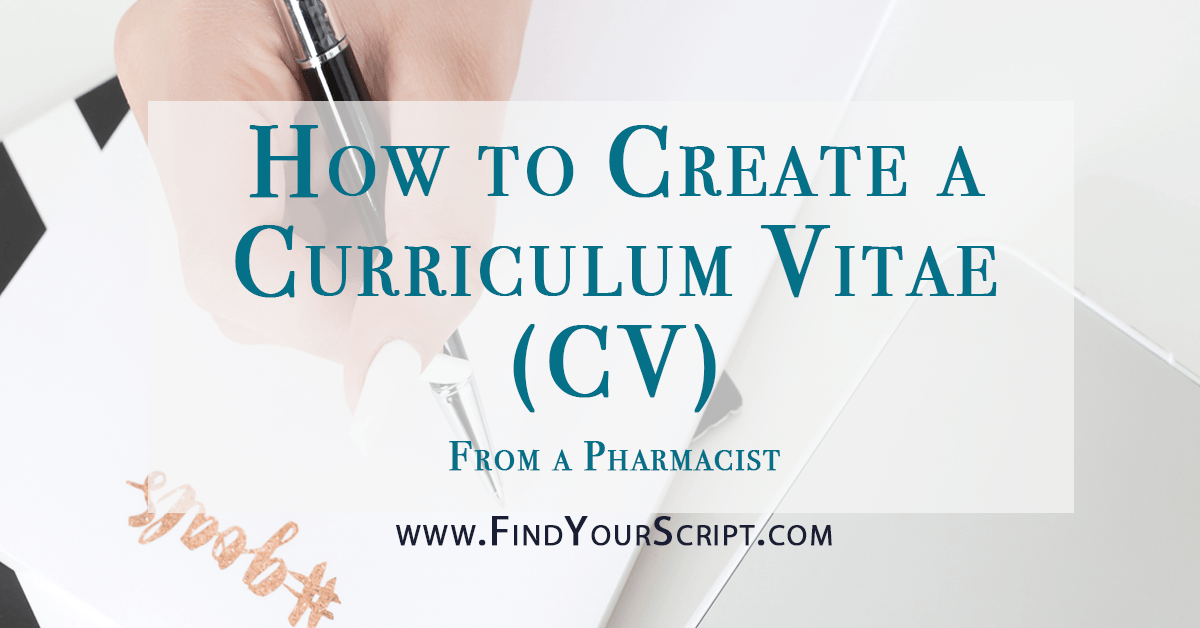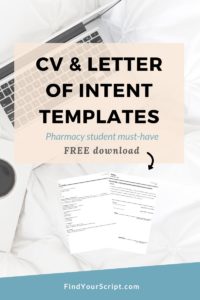
How to Create a Curriculum Vitae (CV) | From a Pharmacist
Creating a Curriculum Vitae (CV) or Resume is an important step in the professional development process. Today, I’m talking about my tips for creating the best CV. This advice is to presented to help students on his/her road to Residency Applications (particularly pharmacy students) but can be broadly applied to any setting involving CVs.
Download my CV template below after reading this article!
Grab your FREE Templates Today!
Watch on YouTube
What is a Curriculum Vitae (CV)?
A CV is a brief report of a person’s qualifications, education background, work and personal experiences that is typically submitted with job applications. It differs from a Resume – basically it’s longer in length and more detailed.
Steps to Prepare your CV:
1. Gather all materials before sitting down to write your CV. This includes:
- Education history
- Licenses (number, expiration date) – higher on CV for licensed professionals, lower on CV for students
- Certificates (organization affiliated with, expiration date)
- Work history (supervisor names, locations, responsibilities)
- For pharmacy students – IPPE and APPE rotations (preceptor names, locations, responsibilities)
- Leadership history
- Research and publication history
- Presentation history
- Professional service activities (community service work, health fairs, etc)
- Organization affiliations (memberships, committee work, conferences)
- References
Ok, the list above may be overwhelming at first glance. My advice is to keep a continual portfolio of this information, preferably electronically, to easily update your CV once monthly. For safe keeping, I recommend saving this portfolio to an online system such as Dropbox to ensure you never loss all your information if your computer crashes.
2. Download a CV template – mine is available here
3. Start typing in the information you gathered above into the template
4. Remember to add in:
- Header or footer with your name, page number and date updated. This is helpful if you send your CV to someone and the pages get mixed up or for easy reference. CVs tend to get longer and longer with time and reading the 20th page of CV and forgetting who’s it is can be challenging
- Your personal information – this can include your address, email address, phone number. Add what you are comfortable communicating with – if you prefer to include only the city & state you live in, then just include these. Remember CVs could be sent to many people you encounter and how many people do you want to have your personal information?
- Be as specific as possible – we can’t read your mind nor should we make assumptions about what you did during prior experiences. Use bullet points to emphasize and summarize what your roles and responsibilities were related to different activities and positions. Be concise but specific. *Pharmacy students, no not all IPPE and APPE rotations are created equal. Just because you think everyone knows what students do during a rotation at CVS Pharmacy does not mean you should not include highlighted responsibilities. Emphasize unique responsibilities, projects or interactions to showcase why your experience was an integral part of the learning process.
5. In regards to References
- I personally recommend stating “Available upon request” underneath References. Depending on where you are sending your CV, you should consider customizing who you will disclose as references. I may have 3 references talking about my critical care background versus 3 talking about my academia experience and so on.
- In addition, this keeps personal information about your References confidential. Most people do not want their email address or cell phone numbers handed out to tens to hundreds of people…
6. Important Points to Consider
- Be HONEST. NEVER put anything on your CV that is not the truth.
- Assess your knowledge before including it. Ask yourself, can I speak about this project that I completed 3 years ago or this research publication that I’m 4th author on? If the answer is no, then either remove it from your CV or find the file (it should be in that electronic portfolio I mentioned above) and study it. EVERYTHING YOU PUT ON YOUR CV IS FAIR GAME FOR QUESTIONS DURING AN INTERVIEW.
7. Edit
- Gather 3-5 editors to review your CV.
- I recommend someone within your field (potentially a mentor, professor or preceptor), someone outside your field (family member or friend) and someone who loves English and grammar (take out that red marker!).
Grab your FREE Templates Today!
Products I recommend:
There are a few paper planners that really made a difference in how I plan and reach my goals that I’d love to share with you.
-
- My personal planner using my signature Clarify Simplify Align framework – now available on Amazon!
- 5-Minute Gratitude Journal— these BEST way to reflect and bring intention and gratitude back into life. Feeling stress? Use this for just one week and you’ll feel happier and more fulfilled!
- PowerSheets — these are easy-to-follow goal sheets. They dig deep into prioritizing what matters most in your life.
- inkWell Press planner— fully customizable and amazing disc system to add and remove papers easily throughout the year
- Full Focus Planner — a 90-day goal system. Sleek and simple with extra tutorial videos from Michael Hyatt to launch you into a successful 90-day plan!
- Erin Condren — fun & colorful with 3-different ways to customize. Use the full planner or simple condensed notebooks & gratitude journals to fit your life.

